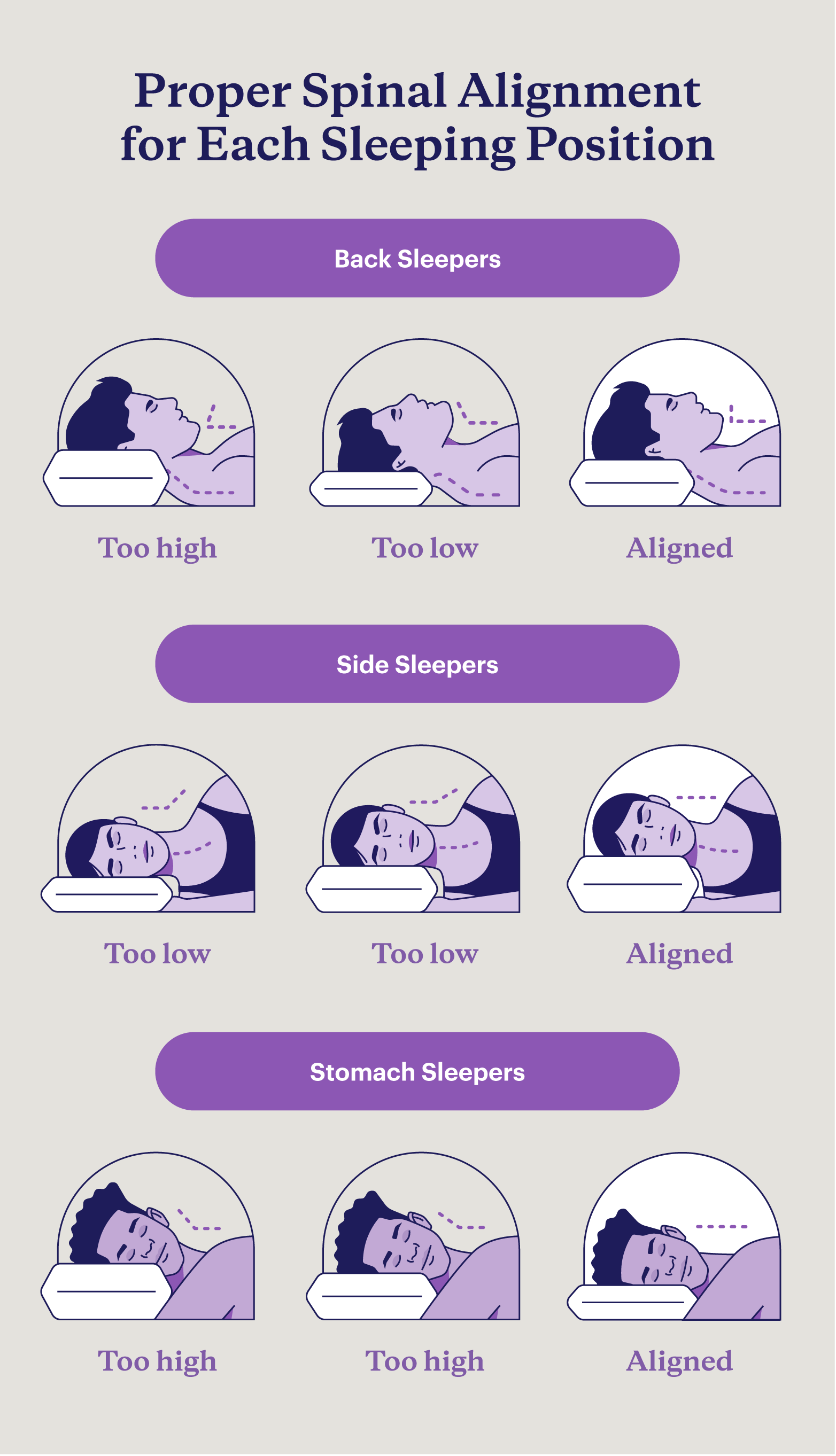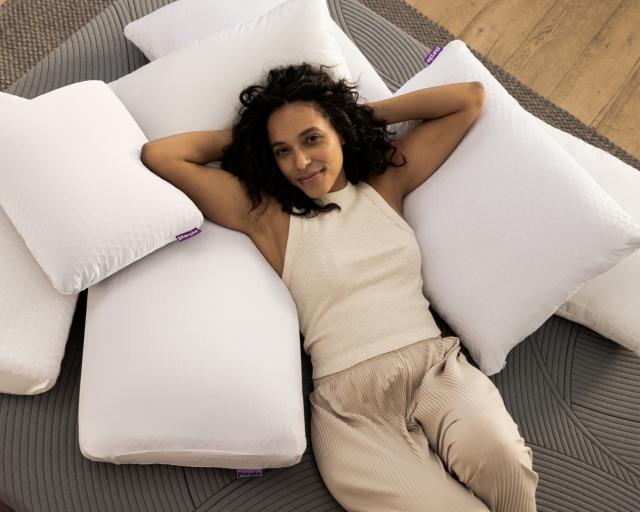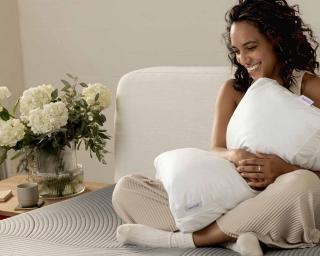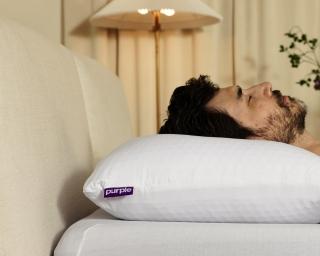
How To Choose a Pillow That’s Right for You [Infographic]
If you consistently wake up with neck pain, it may be time to get rid of your old pillow.
But knowing you need a new pillow and knowing what type of pillow you need are two very different things. With so many options, it can be hard to know how to choose a pillow.
This article will walk you through everything that goes into choosing a pillow, from material to sleeping position, so you can find the best pillow for you.
What Pillow Is Right for You?
Finding your dream pillow is a personalized journey influenced by your unique sleep needs, preferences, and physical considerations. Your sleeping position may also determine how much support you may need in a pillow to achieve proper spinal alignment.
Other factors like allergies, if you’re a hot sleeper, or if you move a lot throughout the night may also play into the decision. At the end of the day, the best type of pillow is highly personalized to your needs and ideal pillow position, but here are a few factors to consider to help figure out what those needs look like.
1. Choose Your Feel or Type
The first decision to make is the feel –– whether you need a firm or soft pillow –– and what kind of filling material you want in a pillow. Each pillow type will have a different firmness level that personal preferences and sleeping positions will play into (more on this later).
Here are the different types of filling materials you can choose from and their corresponding feel:
- Down and feather (soft to medium): Down and feather pillows are fluffy. They’re also extremely durable and breathable.
- Down alternative (soft to medium): A down alternative pillow is a hypoallergenic option that uses synthetic materials like cotton or polyester microfibers to mimic the light and airy feel of traditional down pillows. They’re also very breathable, which makes them great for hot sleepers.
- Shredded foam (soft to firm): Usually made from memory foam or poly foam, shredded foam pillows offer a balance of support and comfort. They can also be adjustable to achieve the level of support you need. They’re soft, highly moldable, and retain heat.
- Foam (soft to firm): When it comes to support, memory or poly foams are great options, as they shape to your head and neck and maintain firmness and shape over time. On the other hand, they tend to be less breathable so it may be harder to stay cool.
- Latex (medium to firm): Latex is a special kind of foam that offers incredible support and durability. It’s also a bit more breathable than memory or poly foam. It’s made from natural materials.
2. Factor in Your Budget
The cost of a pillow varies based on materials and craftsmanship. While you may be tempted to opt for the most budget-friendly option, think of pillows as an investment in your sleep quality and overall wellness.
High-quality pillows may be pricier, but they may also offer better durability, support, and comfort. They still come in a range of cost options, with Purple pillows ranging from $69 to $249.
3. Evaluate Support Needs
Finding your ideal pillow height is crucial for achieving the best quality of sleep and minimizing neck pain. Research shows that the shape and height of your pillow affect spinal alignment while you sleep. The goal is for your head and neck to align with your spine for optimal support, which is why choosing the right neck support pillow can make a significant difference in your comfort and overall sleep quality.
“The spine plays a crucial role in supporting the body's structure and facilitating nerve communication. Choosing the right pillow loft is essential for spinal alignment and can alleviate neck, shoulder, and back pain,” explains Steven Fiore, MD, Board-Certified Orthopedic Surgeon. “The correct loft helps keep the head and neck in a neutral position, reducing strain on muscles and minimizing the risk of pain and discomfort.”
The standard pillow height is usually between 4 and 7 inches, but it will depend on personal preference, sleeping position, fill material, and body type. It’s important to note that different types of fill materials will also compress more or less than other types. For instance, down and down alternative pillows will compress more than a memory foam or latex pillow.
When it comes to body type, someone with broader shoulders, for example, might need a higher loft pillow to fill the gap between their neck and the mattress. On the other hand, someone with a smaller frame may prefer a lower loft pillow to avoid elevating their head too much.
4. Consider Features
There are also different features to consider depending on your sleep needs. For instance, if you sleep hot, you may prefer a more breathable pillow. Or if you have bedroom allergies, you’ll be best off with a hypoallergenic pillow.
Additionally, there are different shapes of pillows to consider:
- Ergonomic: This pillow shape is specially designed to provide neck support with a contoured shape that matches the curvature of your neck. While they can help improve your sleep posture and alleviate pain, they do have an adjustment period and may limit your sleeping positions.
- Adjustable: An adjustable pillow has a removable inner filling that allows you to customize the loft and firmness of the pillow to your liking. This is especially helpful for combination sleepers.
- Cooling Technology: If you’re a hot sleeper, you may want to opt for a pillow with cooling features. For instance, the GelFlex Grid® (also known as the Gel Matrix™) in some of our pillows allows for more airflow to keep you cool all night long.
5. Assess Pillow Size
Finally, you need to consider pillow size. Think about your mattress dimensions, sleep habits, and how you want your bed to look before choosing from the following sizes:
- Standard (20x26 inches): This is a versatile option for most mattress sizes, though they may seem small on a king-sized mattress. Its manageable size makes it easily adjustable for different sleeping positions. However, its limited width may not be enough support for restless sleepers.
- Queen (20x30 inches): A queen pillow offers additional space, making it ideal for restless sleepers. One thing to consider is that using standard pillowcases may make the pillow too firm or lofty.
- King (20x36 inches): This is the largest pillow size, and its length makes it the top choice for restless sleepers. The flip side is that it will take up more space on smaller mattresses.
- Body: These pillows offer support along your whole body, which can improve your spinal alignment and comfort in various sleeping positions. However, they take up more space in bed than a standard pillow.
- Travel: A travel-sized pillow is designed specifically for neck support to keep you comfortable on the go.
Make sure you have the right pillowcase size to protect your pillow from dust, dirt, and sweat. You’ll need a different pillowcase for most sizes, though you may find options that work for both full and queen beds.
Best Pillows for Back Sleepers
Everyone’s preferences are different, so any pillow type could work for back sleepers. But when shopping for a new pillow, here are some general guidelines that tend to work well when learning how to sleep on your back:
- Low to medium loft: A medium or low loft pillow ensures enough support so that there’s cushion between you and the mattress but not so much that your head and neck are crunched upward. People with small to medium frames may prefer a lower loft while those with medium to large frames may feel more comfortable with a medium loft.
- Medium firmness: A medium-firm pillow will keep your head supported so it’s aligned with your spine all night long. A soft pillow won’t be able to retain its shape throughout the night.
Consider the Purple Harmony™ Pillow, one of Purple's best cooling pillows in a low or medium loft if you’re a back sleeper. You’ll have just enough support without your pillow falling flat throughout the night.
Best Pillows for Side Sleepers
The best pillows for side sleepers range from medium to tall lofts and are ultimately whatever you find comfortable, but in general, you should opt for a higher loft pillow.
Sleeping on your side creates a gap between your head and the mattress, and a taller loft helps fill this space, preventing your head from tilting downward or being uncomfortably elevated. It will also help make sure your shoulder isn’t bearing all of your weight, which can cause shoulder pain from sleeping on your side.
- Medium to tall loft: Side or combination sleepers with medium-to-large frames should choose a medium loft pillow, while those with a larger frame should opt for a taller loft. Some people also may prefer one over the other for comfort.
- Medium to firm: You need enough firmness to support your head and neck while you sleep. Similar to back sleepers, a pillow that's too soft will allow your head to sink and throw off your alignment.
The Purple Harmony™ Pillow in a medium loft caters perfectly to the needs of side sleepers with a supportive yet soft feel that contours every curve. Its honeycomb-patterned Matrix™ technology surrounds a ventilated latex core, ensuring it won’t fall flat throughout the night. It comes in three different lofts, but we generally recommend a medium or tall loft for side sleepers.
The Purple Freeform Pillow™ is also a great option for side sleepers. With removable, adaptable MicroFlex™ Moon Foam, you can adjust the pillow to suit your exact support needs.
Best Pillows for Stomach Sleepers
If you sleep on your stomach, you may find that different types of pillows work for you. But if you want some extra guidance for your sleep position, here are some pointers for stomach sleepers:
- Low loft: In this sleeping position, the less your head is propped up, the better. A thin pillow will ensure your head and neck align with your spine as much as possible. People with a smaller frame may also prefer a lower loft.
- Soft feel: Soft support will offer a bit of cushion between you and a supportive stomach sleeper mattress without lifting your head too much.
The Purple Freeform Pillow™ works well for stomach sleepers as you can remove MicroFlex™ Moon Foam to your liking. You can achieve a lower loft if you prefer or build up extra support if needed to keep your neck supported all night long.
Which Purple Pillow Is Right for You?
The process for how to choose a pillow will be unique for everyone, guided by your individual needs. Understanding factors like loft, firmness, fill materials, and more can help you find your ideal match.
Once you know what you’re looking for in a pillow, you can compare Purple pillows and find the right one for you. No matter which Purple pillow you choose, each is designed to stand the test of time and help you get the best quality of sleep possible.
More to Explore
Level-up your sleep routine with our most-loved products.
FAQ
You should replace your pillow every one to two years for the best support and sleep quality. Pillows wear down and dust and bacteria build up over time, so they need to be replaced to be fully effective and hygienic.
The best kind of pillow to sleep on depends on each person’s unique needs and preferences. Take into account your sleeping position, how much support you need, how many pillows you sleep with, and the pillow loft you find comfortable when choosing the right pillow for you.
Latex and memory foam pillows may be best for neck pain, as they offer more support than other pillow types and don’t compress as much as a down or down alternative pillow throughout the night.
Ergonomic pillows may help provide additional support to cut down on neck fatigue. An adjustable shredded foam pillow can also offer relief from neck pain as you can add or remove filling to achieve the perfect amount of support.












